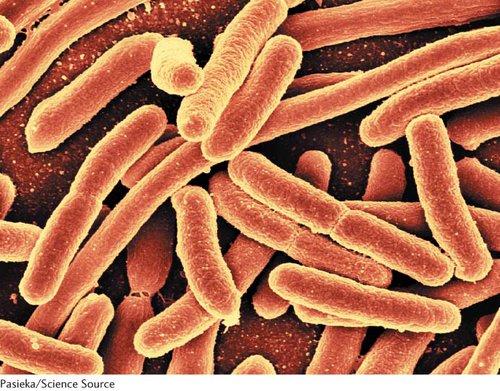12
Control of Gene Expression
Operons and the Noisy Cell

In 2011, geneticists from around the world celebrated the 50th anniversary of the operon. An operon is a group of genes that share a common promoter and are transcribed as a unit, producing a single mRNA molecule that encodes several proteins. Often, these proteins are functionally related in some way; for example, the trp operon in the bacterium Escherichia coli encodes components of three enzymes that work together to synthesize the amino acid tryptophan. Operons control the expression of genes such as these by regulating their transcription. Genes in bacteria are often organized into operons, but operons are much less common in eukaryotes.
The operon was discovered through the elegant research of François Jacob and Jacques Monod, who worked at opposite ends of the attic floor of the Pasteur Institute in Paris. Jacob was studying bacteriophage λ, a virus that infects E. coli; Monod was analyzing the properties of β-galactosidase, an enzyme E. coli uses to metabolize the sugar lactose. One summer evening in 1958, Jacob had a flash of inspiration: he saw a connection between the research taking place at the two ends of the attic. Jacob recognized that the genes that induce phage reproduction were controlled in the same way as the genes that control production of β-galactosidase in E. coli. This realization led to an important collaboration between Jacob and Monod, who eventually uncovered the structure and function of the lac operon in 1961. In 1965, they were awarded the Nobel Prize in Physiology or Medicine along with their collaborator Andre Lwoff.
Following Jacob and Monod’s discovery of the lac operon, other operons were discovered in bacteria and a great deal of research was focused on the mechanism of operon function. Despite extensive research on how operons work, much less is known about why operons exist: Why do prokaryotes have them while eukaryotes don’t? Why are some genes included in operons and others are not? These questions intrigued Oleg Igoshin, at Rice University, and Christian Ray, at the University of Texas MD Anderson Cancer Center. Igoshin and Ray are computational biologists, a new breed of scientists who use complex mathematics to study fundamental problems of biology. They took what might seem like an unlikely approach to the question of why operons exist. Instead of growing bacteria, inducing mutations, and examining DNA, they developed a series of mathematical models of gene networks that could be run on a computer. Using these models, they looked at how genes functioned when grouped into operons and when regulated separately.
Igoshin and Ray knew that random fluctuations in the levels of transcription and translation occur naturally. Because of these fluctuations—
To test their hypothesis, Igoshin and Ray ran computer models for six different types of interactions between the products of the kinds of genes that are potentially found in operons. The models showed that for some types of protein interactions, grouping genes together in an operon decreases the biochemical noise. For other types of protein interactions, grouping the genes in operons actually increases the noise. Thus, operon structure has the potential to increase or decrease noise, depending on which genes are grouped together.
Igoshin and Ray then examined genes that are actually found in operons in E. coli and discovered that operons containing genes whose interactions decrease noise were more common than expected on a random basis. Conversely, operons whose gene interactions increase noise were less common than expected. They concluded that operons have evolved as a way for the cell to couple transcription of genes so as to reduce biochemical noise in the cell, allowing the cell to more finely tune the relative proportions of the proteins encoded by the operon. Igoshin and Ray speculated that operons are less common in eukaryotes because the larger volume of eukaryotic cells reduces the effect of random fluctuations and, perhaps, because eukaryotes have other mechanisms (such as changes in chromatin structure) to couple the transcription of different genes.
Gene regulation, which encompasses the mechanisms and systems that control the expression of genes, is critical for the control of numerous life processes in all organisms and is the focus of this chapter. We begin by considering the levels at which gene expression is controlled and the difference between genes and regulatory elements. We then examine gene regulation in bacteria, including the structure and function of operons, as well as gene regulation in eukaryotes. Next we consider some of the similarities and differences in gene regulation of bacteria and eukaryotes. Finally, we explore the role of epigenetic effects in the control of gene expression.